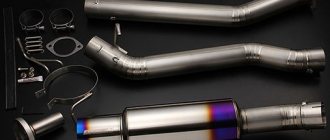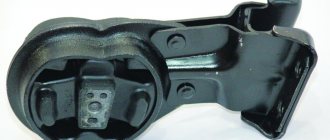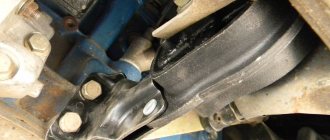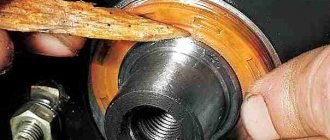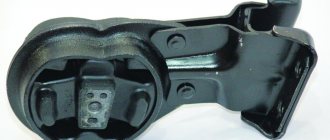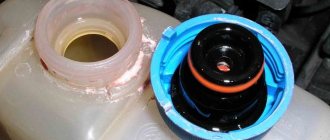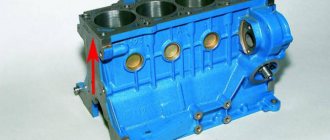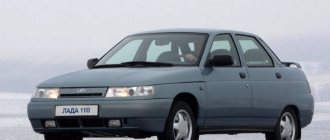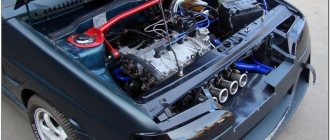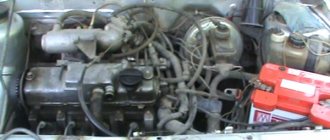If you need to remove the engine, then there are two options - contact a service station or dismantle the unit yourself. There are two ways to remove the engine - lower it down and raise the car, or do the opposite - pull out the power unit through the top. It is impossible to do this without help, since the weight of the VAZ-2109 car engine is quite large.
Conclusion
The VAZ 2109 engine, or rather its varieties that were installed on the car, became legends of the Soviet automobile industry. So, having a fairly small size, it was powerful, which gave it great popularity among motorists. Another positive factor was that repairing the VAZ 2109 engine is quite easy to do with your own hands, which allows any car enthusiast to reduce costs at a car service center.
With the popularization of tuning, most drivers who owned 2109 engines began to carry out modifications and, as practice shows, quite successfully.
Reducing the weight of passenger cars
The weight of any car is the most important parameter, which is directly related to the fuel consumption of a particular model. An increase in vehicle weight with the same technical characteristics of the power unit increases fuel consumption by approximately 5%. Therefore, the Volzhsky Automobile Plant, like any automaker, is constantly striving to reduce the weight of cars produced.
For comparison, the VAZ-2101 weighed 955 kg, and the VAZ-2109, which had increased in height and width, weighed 915 kg. This result in the design of the “nine” was achieved through the use of a significant number of elements and parts made of high-strength metal, aluminum and plastic. The main ones include:
- plastic door trim;
- plastic bumpers;
- plastic door sills;
- a large number of plastic inserts and bracket linings.
- aluminum radiator, etc.
The total weight of plastics used in the VAZ-2109 device is 80 kg, or almost 9%.
Tuning
Tuning the VAZ 2109 engine is quite simple and without any particular difficulties. So, the first thing motorists do to their engine is change the ignition system. Of course, on older models there is a contact version installed, which has long been obsolete, and therefore contactless is installed.
At the same time, spark plugs and high-voltage wires are changed. Don't forget about the ignition coil either. All this will give improved fuel combustion in the cylinders only if everything is configured correctly.
Next comes boring and reassembly of the cylinder block. So, many car enthusiasts install a sports piston version, which provides a lightweight crankshaft, pistons and connecting rods. Then, the guide bushings and valves are changed. All these modifications will give an increase in power by about 25-30 horses.
The last stage is external tuning. This may include: installing a zero-resistance air filter, overhauling the carburetor, replacing water cooling pipes, installing an improved pump and generator.
Do not forget about such an important element as the starter, a range of varieties that can be found in tuning stores. It is also recommended to replace the radiator with a lighter one, that is, install an aluminum one. All this will give more opportunities for the engine, and accordingly for the motorist.
Car Features
Passenger cars of the “Sputnik” series, as models 2108 and 2109 were also designated, in addition to the same front-wheel drive, also had a similar appearance, popularly nicknamed “chisel”. Also, small cars had many common body parts and similar overall dimensions, but the weight of the VAZ-2109 was 15 kg more.
The five-door “nine”, compared to the “eight”, was considered by domestic car enthusiasts to be a more practical and versatile car. Such qualities allowed the VAZ-2109 model to first equal the 2108 version in terms of production volume, and in 1998 to become the first in terms of the number of copies produced.
The manufacturer constantly made changes to the design in order to improve the “nine”. Among the most notable are:
- new design of the front part;
- rear wiper;
- hydrocorrector of head optics;
- improved clutch design;
- increased volume of the washer fluid reservoir.
In order to reduce the weight of the VAZ-2109 and 2108, a lighter and easier to manufacture plastic gas tank was developed, but such a tank was subsequently abandoned due to poor ventilation.
How much does the VAZ weigh?
Perhaps one of the most popular cars in the post-Soviet space was, is and remains the VAZ. This car has captivated many generations. However, how did it all begin? When was the first VAZ car produced and how much did it weigh? You will learn the answers to these and other questions from this article.
The first VAZ car was produced by the Volzhsky Automobile Plant on April 19, 1970. The make of this car was VAZ-2101 Zhiguli. Its production was carried out according to the analogue of the Fiat concern. Moreover, VAZ owes its appearance to this particular brand of Fiat 124, produced in 1966. Here, in fact, is it:
As a result of some design improvements, the first domestic car, the VAZ 2101 of 1970, was produced:
The weight of this car was 955 kg. Moreover, of this mass the engine weighed 114 kg.
It has not lost its popularity to this day. In 2000, it was recognized as the best car among eighty thousand car enthusiasts surveyed in the CIS countries and Russia. It was named the best car of the century, VAZ 2101. At the time of its production, it was considered the most comfortable, reliable and modern domestic car. Its presence was a sign of wealth and prosperity!
But the Volzhsky Automobile Plant did not stop there. He created entire collections of this car. Each of them differed in its configuration, as well as its total weight. Therefore, now we will compare some VAZ models by their weight.
- VAZ 2102 has a weight of 1010 kg.
- VAZ 2103 weighs 965 kg.
- VAZ 2104 has a weight of 1020 kg.
- VAZ 2105 has a weight of 1060 kg.
- VAZ 2106 weighs 1045 kg.
- VAZ 2107 weighs 1049 kg.
- VAZ 2108 weighs 945 kg.
- VAZ 2109 weighs 915 kg.
- VAZ 2110 has a weight of 1020 kg.
- VAZ 2111 weighs 1055 kg.
- VAZ 2112 has a weight of 1060 kg.
- VAZ 2113 weighs 975 kg.
- VAZ 2114 weighs 985 kg.
- VAZ 2115 weighs 1000 kg.
- VAZ 2116 weighs 1276 kg.
- VAZ 2117 weighs 1110 kg.
- VAZ 2118 has a weight of 1110 kg.
- VAZ 2119 has a weight of 1110 kg.
- VAZ 2120 has a weight of 1110 kg.
- VAZ 2121 has a weight of 1550 kg.
- VAZ 2122 has a weight of 1122 kg.
- VAZ 2123 has a weight of 1300 kg.
But this is the total weight of a VAZ car. As for some parts of the car, the weight of, for example, a VAZ 2106 can be decomposed as follows:
- The weight of the engine with equipment is 140 kilograms.
- The weight of the gearbox is 26 kilograms.
- The weight of the square shaft is 10 kilograms.
- The weight of the rear axle is 52 kilograms.
- The weight of the radiator is 7 kilograms.
- Body weight – 280 kilograms.
On average, the weight of all components of a VAZ car has approximately the same mass. Throughout the entire period of existence of this car, quite interesting facts have been recorded that simply cannot be ignored. It’s hard to imagine that a car weighing an average of 1 ton is very popular.
So, the VAZ 2121 Niva car is not only the most popular throughout the USSR, but also the most exported. Just imagine, this model was produced in 1.8 million cars. And of this amount, 500,000 were sold to more than 100 countries. As we remember, the weight of the VAZ 2121 is 1550 kilograms. This means that over the entire period, 775,000,000 kilograms of this car were sold! Also, this particular model of all Soviet cars was driven in Japan. As for the design of the VAZ 2108, it was developed by the currently well-known company Porshe. The weight of its engine is 127.3 kilograms. This became necessary due to the fact that the demand for this brand of car was greatly reduced. For this reason, they decided to modernize it.
Moreover, the VAZ car became more popular because the Lada car was the first car of the famous Formula 1 racer - Kimi Raikkonen. His father loved this car extremely much for its reliability.
So, we learned that each VAZ car model has its own separate weight. But throughout the history of its existence and production, it has not undergone major changes.
Disadvantages, breakdowns and problems of the Lada Samara box
The reliability of the manual transmission is weak, the transmission is famous for unclear shifts and howling
Gears switch off spontaneously due to wear of the locks on the couplings and gears
The box hums most often due to a lack of lubrication or when the bearings are damaged.
A strong crunch when switching hints at a quick replacement of synchronizers
The weak point of the gearbox is the rocker; it often requires repair or replacement
Another common problem is oil leaks from different seals.
You can contact the site administrator by email: [email protected]
All texts were written by me, are authored by Google, included in the original Yandex texts and notarized. For any borrowing, we immediately write an official letter on company letterhead in support of search networks, your hosting and domain registrar.
Next we go to court. Don’t try your luck, we have more than thirty successful Internet projects and have already won a dozen lawsuits.
Answers@Mail.Ru: At what speeds should I switch to the 4-speed gearbox of the VAZ-2109?
If you save gasoline, then it is best to switch like this: 1st - up to 20 km/h 2nd - up to 40 km/h 3rd - up to 60 km/h 4th - up to 80 km/h When I need to accelerate very quickly (overtaking for example) I do so: 1st - up to 30 km/h 2nd - up to 55-60 km/h 3rd - up to 80-90 km/h 4th - up to 120 km/h
And as the heart tells you, I mean the engine. How you don’t strain yourself means you can, but if you’re racing... that’s a different story
Usually at 3 thousand rpm (look at the tachometer) they switch to the next gear if you drive in economy mode. But if you participate in racing, you can accelerate to 5 thousand)
don’t get attached to the speed—you need to switch to the next gear around 2500-3500 crankshaft rpm, depending on your driving style. less - the engine accelerates poorly, more - it roars a lot and wears out faster
Up to 2.5-3 thousand engine speeds, if more - excessive fuel consumption...
Every time the car starts to rattle, you need to change the speed, or look at the tochometer and switch when it reaches the 2 -2.5 mark
I focus on the tachometer readings, 3 thousand - I switch.
My instructor said (it was a long time ago, actually): When the engine began to roar, and not purr, it means it’s time to switch gears to the next one - you go faster and more comfortably, and it’s easier for the car!
Damn, everyone gives advice on how to DRIVE! And the man asked how to DRIVE! If you DRIVE, then for greater effect it is better not to switch at all!
you can go up to 140 in fourth When you need to accelerate very quickly, I also did this: 1st - up to 40 km/h 2nd - up to 80 km/h 3rd - up to 110 km/h 4th - up to 140 km/h this is about 5-5 .5 thousand revolutions For more details, see the source

